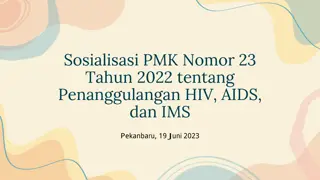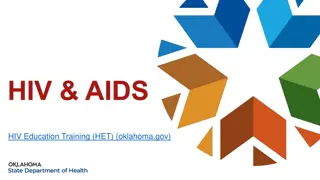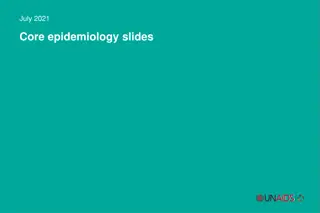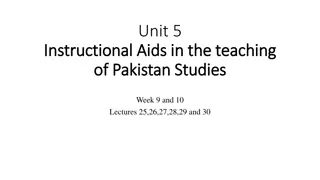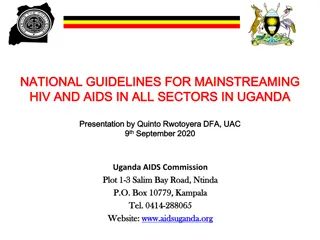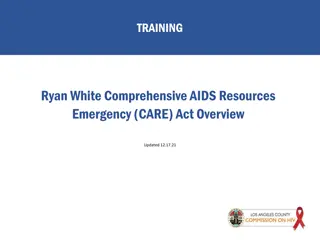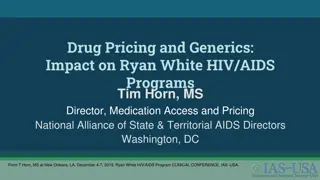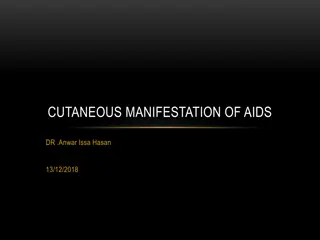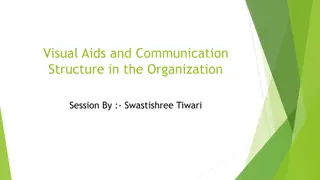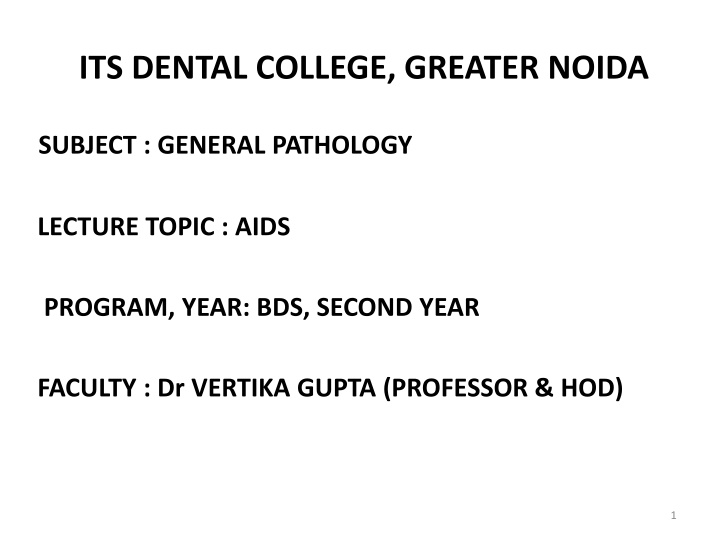
AIDS: Pathogenesis, Clinical Stages & More
Explore the insights into AIDS, including its pathogenesis, clinical stages, and transmission routes. Learn about the structure of HIV, opportunistic infections associated with AIDS, and the impact of the disease on the immune system. Discover the etiological agent HIV, its effects on the immune system and CNS, and the selective tropism characteristics. Uncover essential knowledge for second-year BDS students in General Pathology at ITS Dental College, Greater Noida.
Download Presentation

Please find below an Image/Link to download the presentation.
The content on the website is provided AS IS for your information and personal use only. It may not be sold, licensed, or shared on other websites without obtaining consent from the author. If you encounter any issues during the download, it is possible that the publisher has removed the file from their server.
You are allowed to download the files provided on this website for personal or commercial use, subject to the condition that they are used lawfully. All files are the property of their respective owners.
The content on the website is provided AS IS for your information and personal use only. It may not be sold, licensed, or shared on other websites without obtaining consent from the author.
E N D
Presentation Transcript
ITS DENTAL COLLEGE, GREATER NOIDA SUBJECT : GENERAL PATHOLOGY LECTURE TOPIC : AIDS PROGRAM, YEAR: BDS, SECOND YEAR FACULTY : Dr VERTIKA GUPTA (PROFESSOR & HOD) 1
Learning Objectives & Specific Learning Outcomes Learning Objectives: To explain AIDS with emphasis on its pathogenesis & clinical stages. Specific Learning Outcomes: At the end of the lecture, the learner should have the knowledge about the following with respect to AIDS. 1) Structure of HIV 2) Routes of transmission 3) Pathogenesis 4) Clinical stages 5) Opportunistic infections seen in AIDS 2
AIDS AIDS
Retroviral disease caused by HIV & characterized by infection & depletion of CD4+T lymphocytes and by profound immunosupression, primarily affecting cell- mediated immunity, that leads to neurologic manifestations, opportunistic infections, and neoplasms. Epidemiology AIDS has been reported from more than 190 countries worldwide In India Maharashtra, TN , NE state of Manipur
ROUTES OF TRANSMISSION Sexual contact predominant mode (75%) Parentral transmission Passage of virus from infected mothers to their newborns
Etiologic agent AIDS is caused by HIV, a human retrovirus belonging to the lentivirus family Two genetically different but antigenically related forms of virus have been isolated. - HIV-1 - HIV-2
PATHOGENESIS OF HIV INFECTION AND AIDS Immune system and CNS are two major targets of HIV infection. Profound immunosuppression, primarily affecting CMI, is the hallmark of AIDS. HIV enters body thru mucosal tissues and blood and infects T-cells, dendritic cells & macrophages
1) Selective tropism and internalisation. CD4 acts as high affinity receptor for HIV hence the selective tropism of the virus for CD4+ T cells & other CD4 + cells esp monocytes , macrophages and dendritic cells.
2) Uncoating and proviral DNA integration. Once internalised, RNA genome of the virus undergoes reverse transcription (with the help of enzyme reverse transcriptase), leading to formation of cDNA (proviral DNA) Initially proviral DNA remains in cytoplasm in linear form Later on - DNA circularizes, enters the nucleus and is then integrated into the host genome.
3) Budding and syncytia formation On activation, proviral DNA may be transcribed with formation of complete viral particles that bud from cell membranes. These infected cells may fuse with uninfected cells, forming giant cells.
PATHOGENESIS ATTACHMENT BUDDING
PATHOGENESIS EARLY BUDDING
PATHOGENESIS LATE BUDDING
PATHOGENESIS MATURE NEW VIRIONS
4) Cytopathic effects (cell lysis) - Completion of viral life cycle in latently infected cells occurs only after cell activation and in case of most CD4+ T cells, virus activation results in viral budding & in cell lysis.
5) HIV infection of non T cells (monocytes, macrophages and dendritic cells) In contrast to CD4 +T cells, although these cells are infected with HIV, but they are resistant to cytopathic effect of HIV. Thus HIV can multiply in these cells.
6) Effect on B Lymphocytes- abnormal B cell function. 1. Patients have hypergammaglobulinemia & circulating immune complexes owing to polyclonal B cell activation. 2. Despite activated B cells, patients with AIDS are unable to mount antibody response to new antigens.
7) Pathogenesis of CNS involvement -Macrophages & microglia- predominantly infected with HIV. HIV is carried into brain by infected monocytes.
Major abnormalities of immune func in AIDS A) T-cell abnormalities 1.Lymphopenia with depletion of CD4+ T-cells ( inversion of CD4:CD8 ratio) 2.Preferential loss of memory T-cells 3.Suceptibility to neoplasms 4. delayed type HS 5. response to Antigens
B) B-cell abnormalities 1. Polyclonal B-cell activation 2. Hyper gammaglobulinemia 3. Circulating immune complexes 4. Inability to mount response to new Ag s C) Altered monocyte- macrophage function 1. Decreased chemotaxis & phagocytosis 2. Decreased capacity to present Ag to T-cells D) NK cell abnormalities 1. Decreased cytotoxicity
Natural History & C/F of HIV infection 1. Acute retroviral syndrome( 3-6 wks after inf & resolve spontaneously in 2-4 wks) - High level of virus production - Viremia (high levels of HIV p24 Ag in serum) - Abrupt reduction of CD4+ T-cells later return to near normal - Development of virus-specific immune response ( seroconversion ) which controls initial infection
Clinical features Self limited acute illness with nonspecific symptoms - flu like syndrome Sore throat, rash, myalgias, cervical adenopathy, fever, diarrhea, wt. Loss, vomiting, fatigue Both latent & replicating HIV can be found in CD4+T cells & macrophages
2. Middle, chronic phase(10-12 yrs) Stage of relative containment of virus i.e reflects the equilibrium reached b/w virus & host after initial battle between HIV and the host immune system May last for several years Largely intact immune system, but gradual erosion of CD4+ T-cells
Clinical features: Asymptomatic Persistent generalized Lymphadenopathy Minor opportunistic infections (thrush, Herpes Zoster) Thrombocytopenia
3. Final, crisis phase( Full blown AIDS) i. Breakdown of host defenses ii. Dramatic increase in plasma virus iii. CD4+ T-cells<200 cells/ul & this phase culminates in death of the patient iv. Clinical disease Long lasting fever (>1month) Fatigue Weight loss Diarrhoea( > 1 mth)
v. Multiple opportunistic infections(most common cause of death) A. Helminthic & protozoal inf - Crypto/ isosporidiosis ( enteritis) - Pneumocystosis by P. carnni (pneumonia/ disseminated infection) - Toxoplasmosis (pneumonia/ CNS infection) B. Fungal inf - candidiasis- MC fungal inf (oesophageal, tracheal, pulmonary) - cryptococcosis (CNS inf) - coccidioidomycosis, histoplasmosis (disseminated)
C. Bacterial infections - Mycobacteriosis (M. avium intracellulare, M.tuberculosis) - Nocardiosis ( pneumonia, meningitis, disseminated) - salmonella inf ( disseminated) D. Viral infections - CMV (pulm, intestinal, CNS) - HSV - varicella zoster inf
vi.Seconday neoplasms Kaposi s sarcoma B-cell Non-Hodgkin lymphomas Primary lymphoma of brain cervix cancer, anal CA
vii. Clinical neurologic disease Meningoencephalitis Aseptic meningitis Vascular myelopathy AIDS-dementia complex opportunistic infections neoplasms peripheral neuropathies
MORPHOLOGY Changes are more prominent in lymphoid organs Biopsy specimens from enlarged LN in early stages show - Marked follicular hyperplasia. Enlarged follicles have irregular borders & are present both in cortex & medulla. - Activated monocytoid cells are present in & around sinusoids & trabecular bld vessels. - Medulla contains abundant plasma cells
With disease progression (late phase) - Follicular involution i.e follicles are depleted of cells & organized network of follicular dendritic cells is disrupted. - The germinal centres may even become hyalinized : burnt out LN ( atrophic & small).
Frequently asked Questions 1) Pathogenesis of AIDS 2) Opportunistic infections in AIDS 3) Oral cavity lesions in AIDS 39
Reading List/Reference List Robbins Basic Pathology: Kumar, Abbas, Aster, 9th Edition Essential Pathology for Dental Students: Harsh Mohan, Sugandha Mohan, 5th Edition 40

